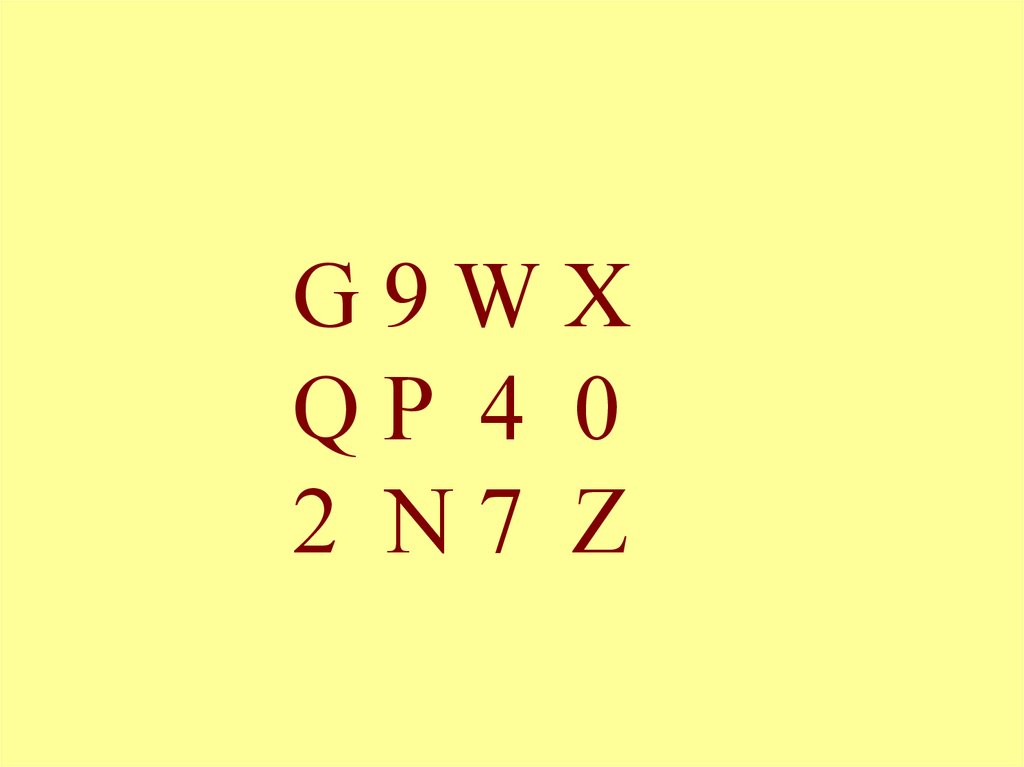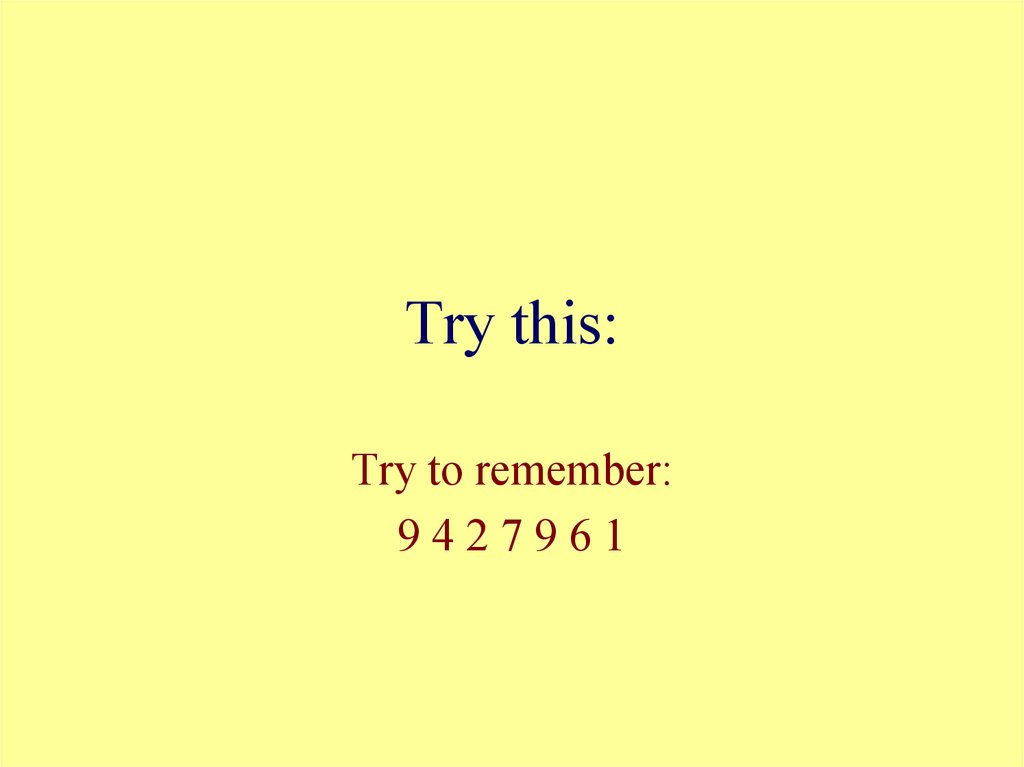Similar presentations:
Sensory memory, Primary memory
1. Sensory memory, Primary memory
2. Today
• Sensory memory and its characteristics• Working memory--a specific model of
primary memory.
3. We’ve talked about perception. . . how much of what you perceive and attend to do you remember?
4. Example
Pick a card, any card5.
Concentrate.No, really. Concentrate!
Alakazam!
6.
I have removed your card!7. The “trick”
8. The point
This trick is based on your notremembering something that you just
encoded. . . A failure of primary memory
9.
These examples begin our study ofmemory—how we retain experience.
Today we’ll talk about memory over
very short periods of time—from 1
second to about 30 seconds.
10. Modal Model
About 1 secondAbout 30 seconds
BUT there are caveats on both of these. . .
11. Early span of apprehension studies
Background: introspectionists were interested in how muchinformation could be in consciousness at one time.
Jevons’ estimate = 100 % accuracy with 5 beans or less
50% accuracy w/ nine beans
12. Span of apprehension
Work like this continued in the early part ofthe century; span estimates were always the
same,but there was a nagging feeling that
something was missing from these
experiments.
Subject frequently said they felt that they
saw more stimuli, but quickly forgot them.
As they were reporting some stimuli, they
were forgetting others.
13. Sperling to the rescue!
Report as many stimuli as possible14.
15.
G9WXQP 4 0
2 N7 Z
16.
Report17.
Now try again, but I’ll ask you toreport only one of the rows.
18.
19.
L R3 UY 8 F 2
C 1 D6
20.
21. Sperling 1960
A Q 6 8T P W 1
2 Y 6 L
Immediate
report
Subjects get
4 correct
(33% of
array)
Immediate
tone cue for
which row
to report
Subjects get
3 correct
(75% of row)
50 ms
A Q 6 8
T P W 1
2 Y 6 L
50 ms
A Q 6 8
T P W 1
2 Y 6 L
50 ms
Tone cue
delayed for
1 second
Subjects get
1 correct
(25% of row)
22. Properties of Iconic memory
• Large capacity--can be pretty accurateon arrays up to 20 characters
• Physical properties; probably little
semantic.
• Lost through decay or masking
23.
Decay actually starts when the stimulus first appears:decay doesn’t start when the stimulus disappears.
then
=
24. Iconic memory decays at onset of stim
Errors increase asduration of first
display increases
25.
You might think it is sustained activation of representationsVisual
Perceptual
Representations
Visual
Perceptual
Representations
It is probably sustained activation of processes
26.
How about primary memory?27. Primary memory
Best theory of primary memory isThe working memory model
This is better than short term memory
from modal model (which sounds
generic, but is a specific model).
28. The Working Memory model
Much of what we know about primary memory wasinspired by a particular model of primary memory
called Working memory
Phonological
Loop
Central
Executive
Visuo-spatial
sketchpad
29. Try this:
Try to remember:9427961
30.
Most people will code this auditorily,that is, in terms of sound
Phonological
Loop
Central
Executive
Visuo-spatial
sketchpad
31. Phonological Loop
The phonological loop has two componentsThe phonological store stores about two seconds worth of
auditory information.
Information can enter the phonological store from the
environment.
Information can also be entered into the phonological store via
the articulatory control process; it is literally the process of
talking to yourself.
32. Predictions
• Since the store lasts 2 seconds, people whocan talk fast have larger capacity
• Since the store lasts 2 seconds, anyone has
small capacity for long words
• Since the store is auditory, you should
confuse words that sound alike (cap, cat, can)
• If you busy the articulators (blah blah blah)
the articulatory control process can’t put
anything on the phonological store, so
you’re forced to code the words some other
way: lo and behold these effects disappear.
33. How else to code?
What do you do if you can’t codeacoustically? You can code in terms
of meaning.
34. Demonstration of meaning coding
35.
Primary memory--representationRelease from proactive interference.
100
80
Percent correct
This result
indicates that
there is also a
semantic code
in primary
memory Note
that working
memory
doesn’t have a
good account.
Professions
60
Meats
Flowers
40
Vegetables
Fruits
20
0
1
2
Trial
3
4
5
36. Visuo-spatial sketchpad
This is where you store visual or spatial information.It is similar to mental imagery, which we’ll discuss
later.
37.
38. Central executive
39.
Working memory = sustained activation of representations.Spatial
executive
Auditory
Semantic
40.
Working memory is important notonly for keeping information around,
but as a staging ground in which
thought happens.
41. Central executive
Cognitive supervisor and/or scheduler, integratinginformation from multiple sources and making
decisions about strategies to be used on tasks









































 psychology
psychology








